BUSN20016: Social Network Marketing vs. Word-of-Mouth Comparison
VerifiedAdded on 2023/04/20
|7
|1379
|328
Report
AI Summary
This research report examines the increasing dominance of social network marketing over traditional word-of-mouth. It addresses the problem statement of how technology drives modern business and the need for decentralized marketing approaches to meet consumer demands. The study investigates the persuasiveness of social networks by comparing them with the traditional word-of-mouth, which has been integrated in the social networking tools, and this has made marketing successful and catchy for companies to their target markets. The research objectives include investigating the consistency of suggestions made by social networking and word-of-mouth users, and comparing the consistency of suggestions made by both. The methodology involves gathering secondary data from various sources and conducting stakeholder interviews. The study utilizes a descriptive approach for data review and correlation analysis to determine the variance between the two marketing approaches. The report concludes by highlighting why social network marketing tools are more persuasive than the traditional word-of-mouth marketing approach.
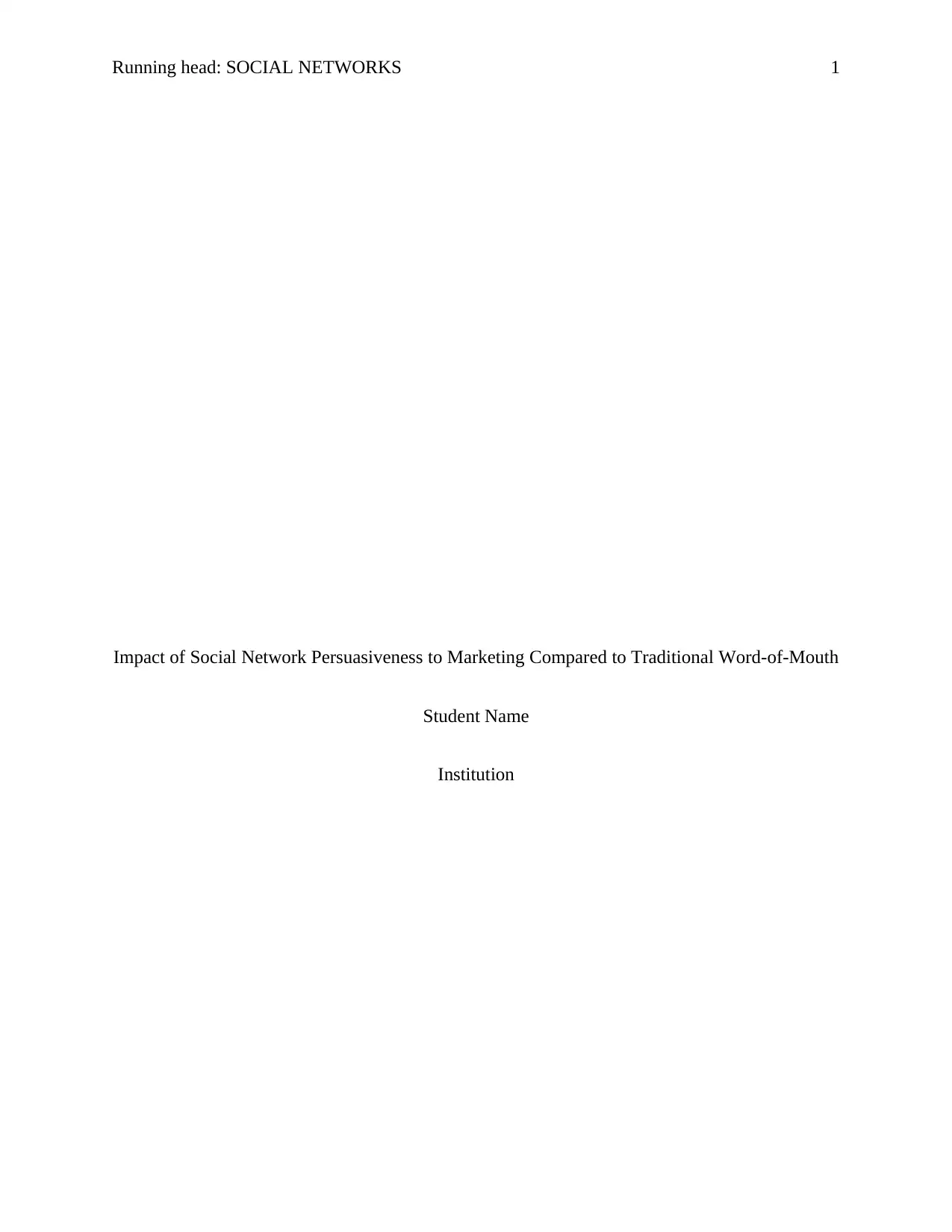
Running head: SOCIAL NETWORKS 1
Impact of Social Network Persuasiveness to Marketing Compared to Traditional Word-of-Mouth
Student Name
Institution
Impact of Social Network Persuasiveness to Marketing Compared to Traditional Word-of-Mouth
Student Name
Institution
Paraphrase This Document
Need a fresh take? Get an instant paraphrase of this document with our AI Paraphraser
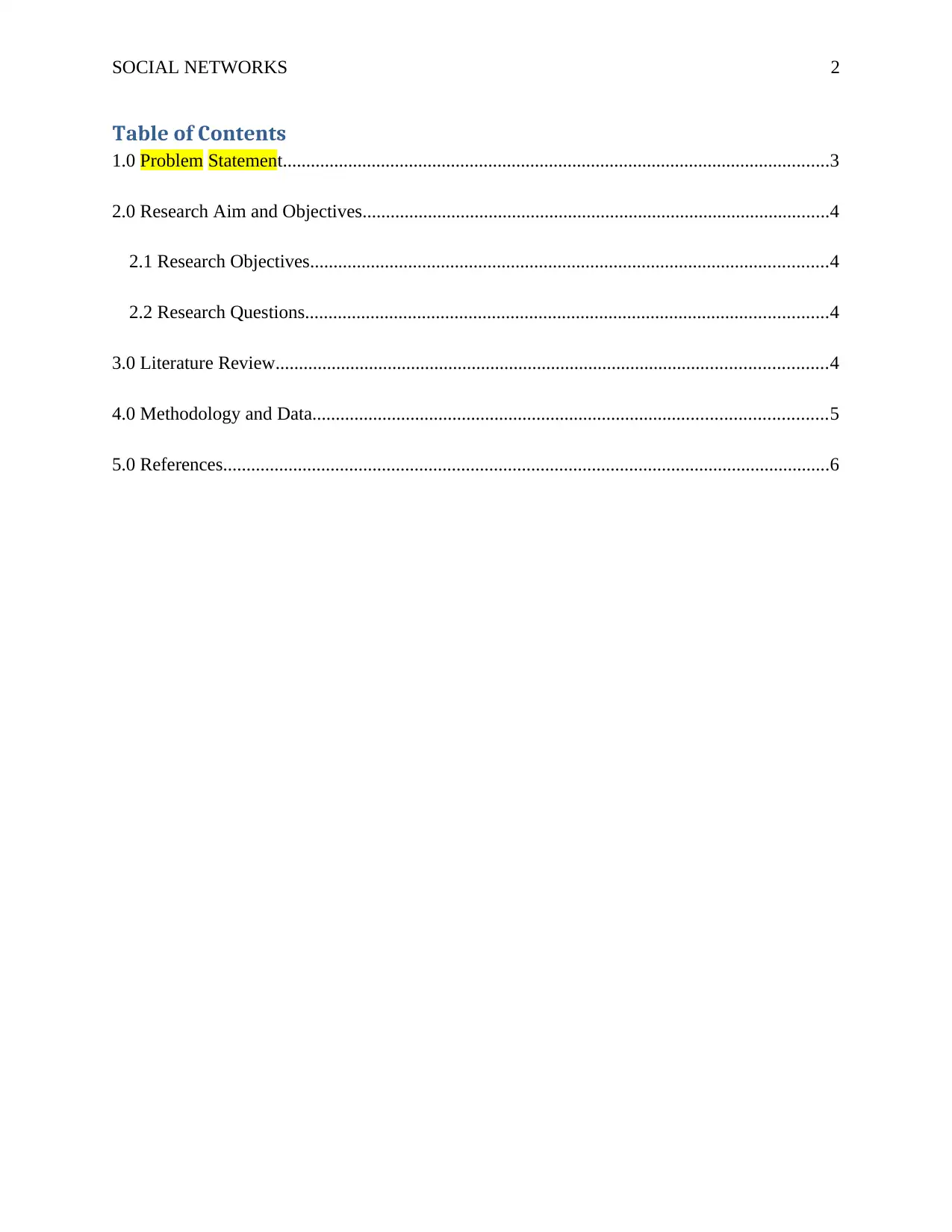
SOCIAL NETWORKS 2
Table of Contents
1.0 Problem Statement.....................................................................................................................3
2.0 Research Aim and Objectives....................................................................................................4
2.1 Research Objectives...............................................................................................................4
2.2 Research Questions................................................................................................................4
3.0 Literature Review......................................................................................................................4
4.0 Methodology and Data..............................................................................................................5
5.0 References..................................................................................................................................6
Table of Contents
1.0 Problem Statement.....................................................................................................................3
2.0 Research Aim and Objectives....................................................................................................4
2.1 Research Objectives...............................................................................................................4
2.2 Research Questions................................................................................................................4
3.0 Literature Review......................................................................................................................4
4.0 Methodology and Data..............................................................................................................5
5.0 References..................................................................................................................................6
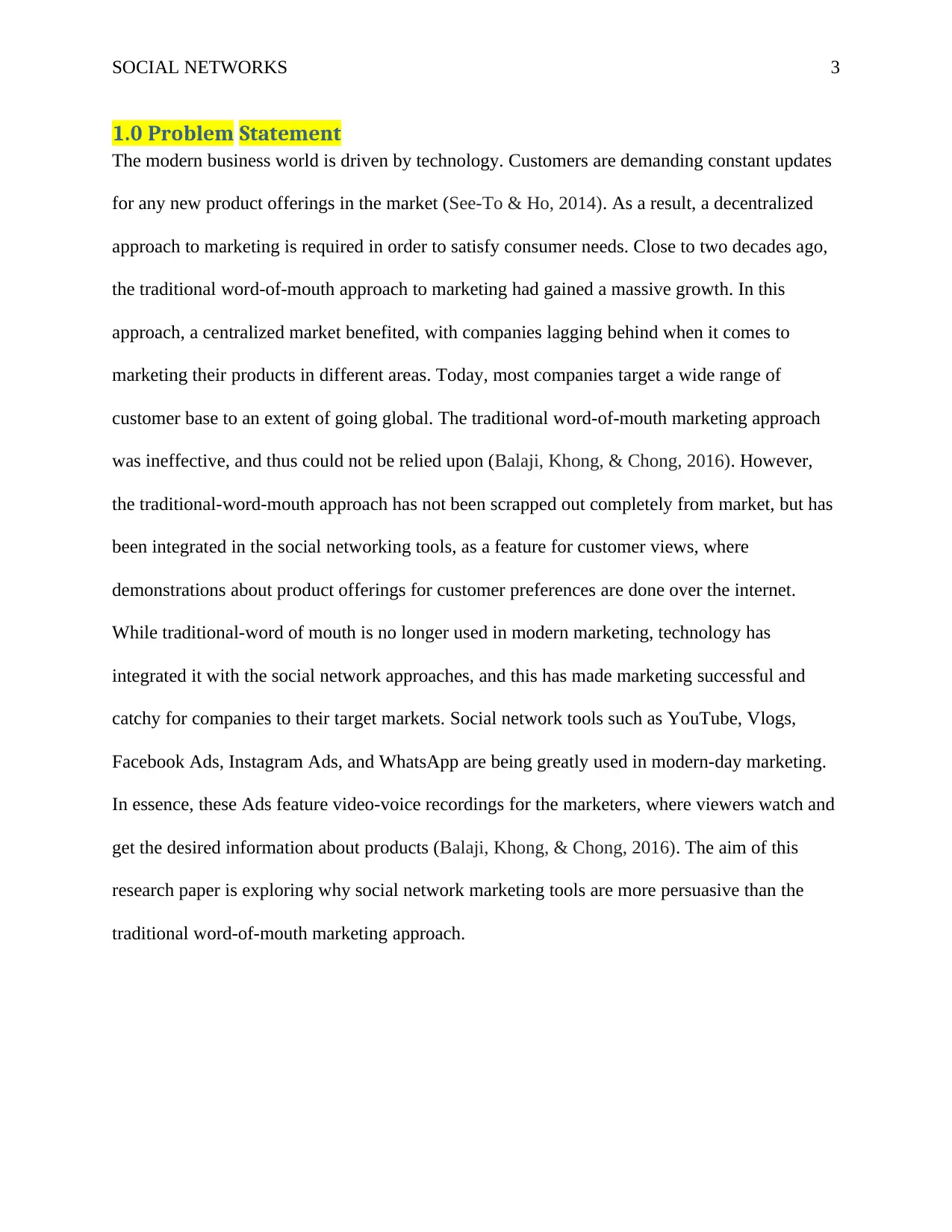
SOCIAL NETWORKS 3
1.0 Problem Statement
The modern business world is driven by technology. Customers are demanding constant updates
for any new product offerings in the market (See-To & Ho, 2014). As a result, a decentralized
approach to marketing is required in order to satisfy consumer needs. Close to two decades ago,
the traditional word-of-mouth approach to marketing had gained a massive growth. In this
approach, a centralized market benefited, with companies lagging behind when it comes to
marketing their products in different areas. Today, most companies target a wide range of
customer base to an extent of going global. The traditional word-of-mouth marketing approach
was ineffective, and thus could not be relied upon (Balaji, Khong, & Chong, 2016). However,
the traditional-word-mouth approach has not been scrapped out completely from market, but has
been integrated in the social networking tools, as a feature for customer views, where
demonstrations about product offerings for customer preferences are done over the internet.
While traditional-word of mouth is no longer used in modern marketing, technology has
integrated it with the social network approaches, and this has made marketing successful and
catchy for companies to their target markets. Social network tools such as YouTube, Vlogs,
Facebook Ads, Instagram Ads, and WhatsApp are being greatly used in modern-day marketing.
In essence, these Ads feature video-voice recordings for the marketers, where viewers watch and
get the desired information about products (Balaji, Khong, & Chong, 2016). The aim of this
research paper is exploring why social network marketing tools are more persuasive than the
traditional word-of-mouth marketing approach.
1.0 Problem Statement
The modern business world is driven by technology. Customers are demanding constant updates
for any new product offerings in the market (See-To & Ho, 2014). As a result, a decentralized
approach to marketing is required in order to satisfy consumer needs. Close to two decades ago,
the traditional word-of-mouth approach to marketing had gained a massive growth. In this
approach, a centralized market benefited, with companies lagging behind when it comes to
marketing their products in different areas. Today, most companies target a wide range of
customer base to an extent of going global. The traditional word-of-mouth marketing approach
was ineffective, and thus could not be relied upon (Balaji, Khong, & Chong, 2016). However,
the traditional-word-mouth approach has not been scrapped out completely from market, but has
been integrated in the social networking tools, as a feature for customer views, where
demonstrations about product offerings for customer preferences are done over the internet.
While traditional-word of mouth is no longer used in modern marketing, technology has
integrated it with the social network approaches, and this has made marketing successful and
catchy for companies to their target markets. Social network tools such as YouTube, Vlogs,
Facebook Ads, Instagram Ads, and WhatsApp are being greatly used in modern-day marketing.
In essence, these Ads feature video-voice recordings for the marketers, where viewers watch and
get the desired information about products (Balaji, Khong, & Chong, 2016). The aim of this
research paper is exploring why social network marketing tools are more persuasive than the
traditional word-of-mouth marketing approach.
⊘ This is a preview!⊘
Do you want full access?
Subscribe today to unlock all pages.

Trusted by 1+ million students worldwide
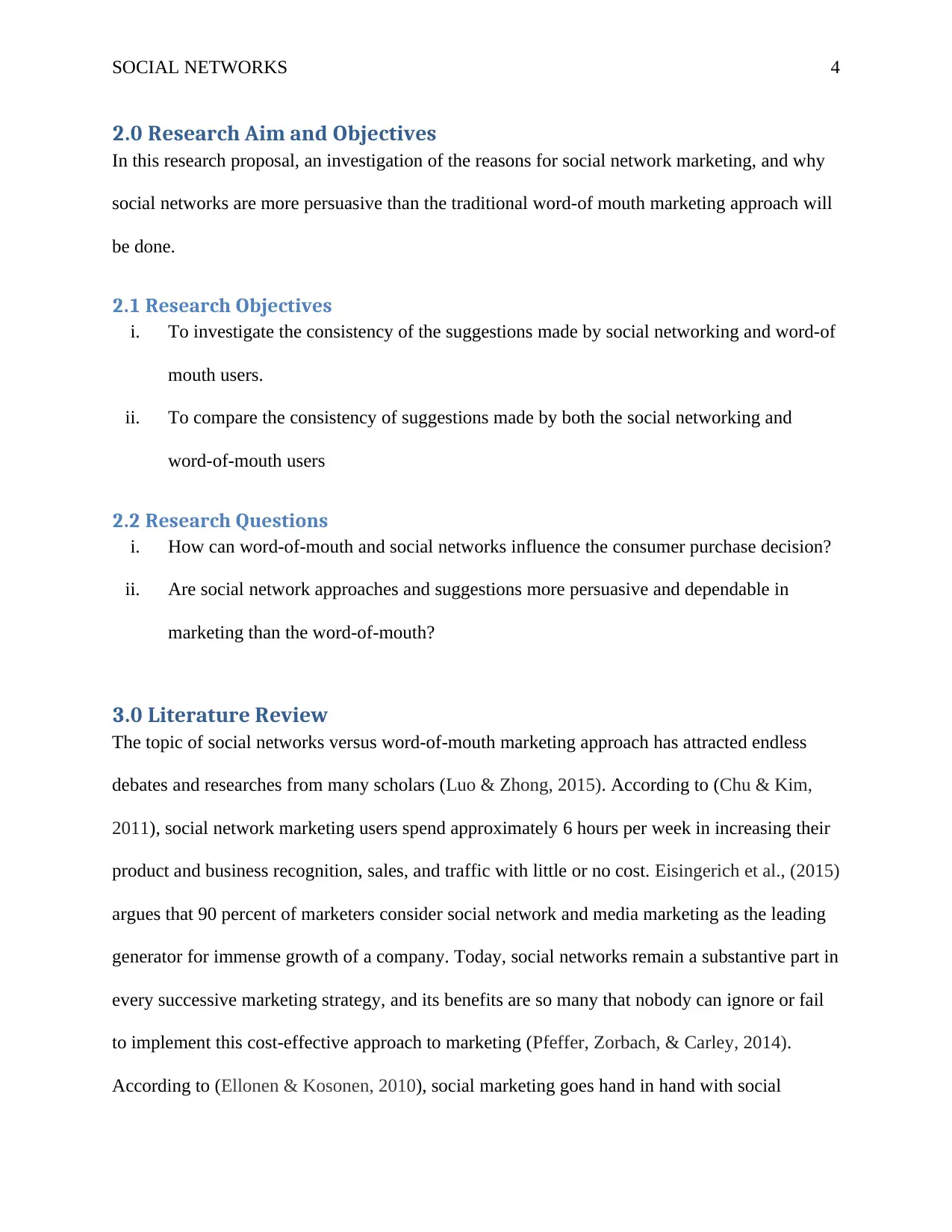
SOCIAL NETWORKS 4
2.0 Research Aim and Objectives
In this research proposal, an investigation of the reasons for social network marketing, and why
social networks are more persuasive than the traditional word-of mouth marketing approach will
be done.
2.1 Research Objectives
i. To investigate the consistency of the suggestions made by social networking and word-of
mouth users.
ii. To compare the consistency of suggestions made by both the social networking and
word-of-mouth users
2.2 Research Questions
i. How can word-of-mouth and social networks influence the consumer purchase decision?
ii. Are social network approaches and suggestions more persuasive and dependable in
marketing than the word-of-mouth?
3.0 Literature Review
The topic of social networks versus word-of-mouth marketing approach has attracted endless
debates and researches from many scholars (Luo & Zhong, 2015). According to (Chu & Kim,
2011), social network marketing users spend approximately 6 hours per week in increasing their
product and business recognition, sales, and traffic with little or no cost. Eisingerich et al., (2015)
argues that 90 percent of marketers consider social network and media marketing as the leading
generator for immense growth of a company. Today, social networks remain a substantive part in
every successive marketing strategy, and its benefits are so many that nobody can ignore or fail
to implement this cost-effective approach to marketing (Pfeffer, Zorbach, & Carley, 2014).
According to (Ellonen & Kosonen, 2010), social marketing goes hand in hand with social
2.0 Research Aim and Objectives
In this research proposal, an investigation of the reasons for social network marketing, and why
social networks are more persuasive than the traditional word-of mouth marketing approach will
be done.
2.1 Research Objectives
i. To investigate the consistency of the suggestions made by social networking and word-of
mouth users.
ii. To compare the consistency of suggestions made by both the social networking and
word-of-mouth users
2.2 Research Questions
i. How can word-of-mouth and social networks influence the consumer purchase decision?
ii. Are social network approaches and suggestions more persuasive and dependable in
marketing than the word-of-mouth?
3.0 Literature Review
The topic of social networks versus word-of-mouth marketing approach has attracted endless
debates and researches from many scholars (Luo & Zhong, 2015). According to (Chu & Kim,
2011), social network marketing users spend approximately 6 hours per week in increasing their
product and business recognition, sales, and traffic with little or no cost. Eisingerich et al., (2015)
argues that 90 percent of marketers consider social network and media marketing as the leading
generator for immense growth of a company. Today, social networks remain a substantive part in
every successive marketing strategy, and its benefits are so many that nobody can ignore or fail
to implement this cost-effective approach to marketing (Pfeffer, Zorbach, & Carley, 2014).
According to (Ellonen & Kosonen, 2010), social marketing goes hand in hand with social
Paraphrase This Document
Need a fresh take? Get an instant paraphrase of this document with our AI Paraphraser
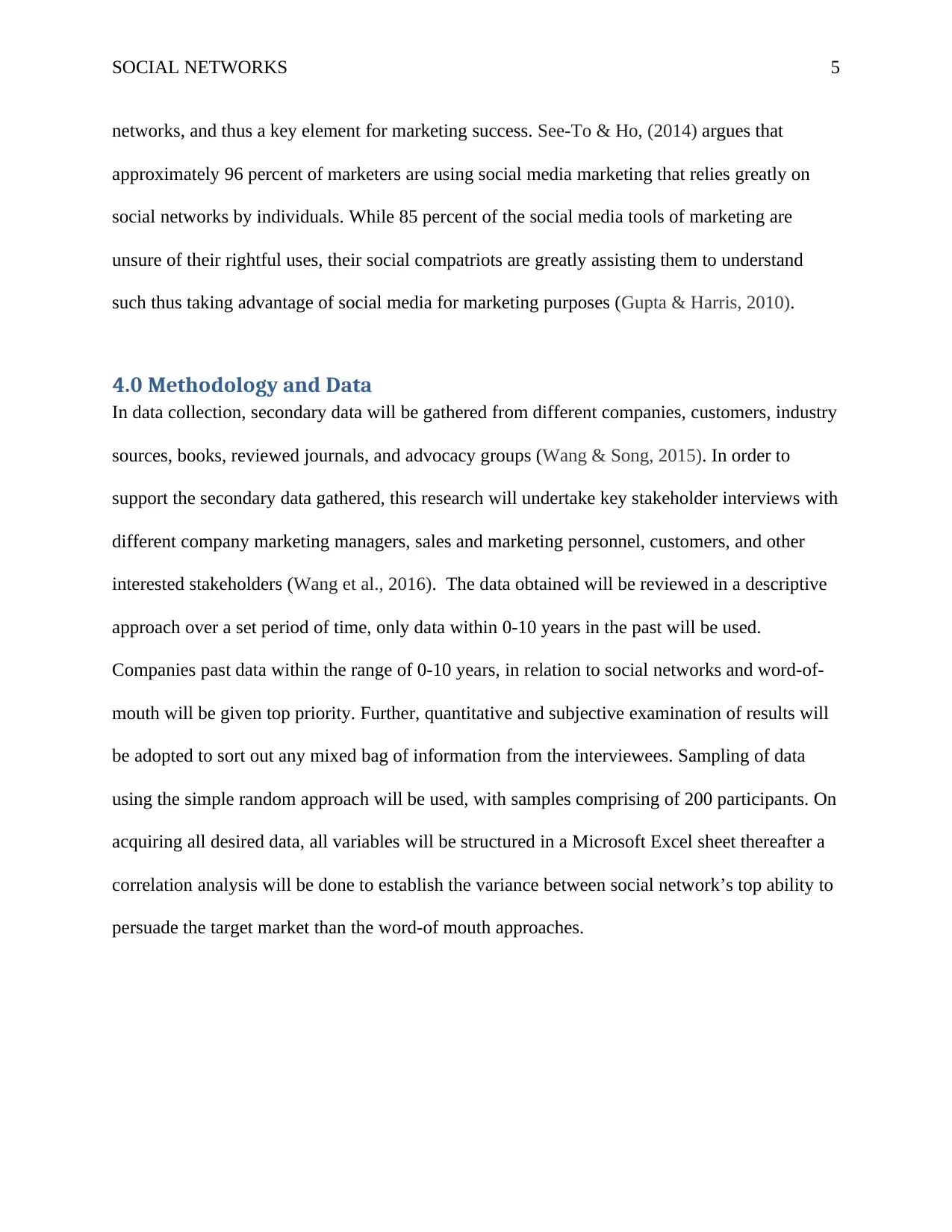
SOCIAL NETWORKS 5
networks, and thus a key element for marketing success. See-To & Ho, (2014) argues that
approximately 96 percent of marketers are using social media marketing that relies greatly on
social networks by individuals. While 85 percent of the social media tools of marketing are
unsure of their rightful uses, their social compatriots are greatly assisting them to understand
such thus taking advantage of social media for marketing purposes (Gupta & Harris, 2010).
4.0 Methodology and Data
In data collection, secondary data will be gathered from different companies, customers, industry
sources, books, reviewed journals, and advocacy groups (Wang & Song, 2015). In order to
support the secondary data gathered, this research will undertake key stakeholder interviews with
different company marketing managers, sales and marketing personnel, customers, and other
interested stakeholders (Wang et al., 2016). The data obtained will be reviewed in a descriptive
approach over a set period of time, only data within 0-10 years in the past will be used.
Companies past data within the range of 0-10 years, in relation to social networks and word-of-
mouth will be given top priority. Further, quantitative and subjective examination of results will
be adopted to sort out any mixed bag of information from the interviewees. Sampling of data
using the simple random approach will be used, with samples comprising of 200 participants. On
acquiring all desired data, all variables will be structured in a Microsoft Excel sheet thereafter a
correlation analysis will be done to establish the variance between social network’s top ability to
persuade the target market than the word-of mouth approaches.
networks, and thus a key element for marketing success. See-To & Ho, (2014) argues that
approximately 96 percent of marketers are using social media marketing that relies greatly on
social networks by individuals. While 85 percent of the social media tools of marketing are
unsure of their rightful uses, their social compatriots are greatly assisting them to understand
such thus taking advantage of social media for marketing purposes (Gupta & Harris, 2010).
4.0 Methodology and Data
In data collection, secondary data will be gathered from different companies, customers, industry
sources, books, reviewed journals, and advocacy groups (Wang & Song, 2015). In order to
support the secondary data gathered, this research will undertake key stakeholder interviews with
different company marketing managers, sales and marketing personnel, customers, and other
interested stakeholders (Wang et al., 2016). The data obtained will be reviewed in a descriptive
approach over a set period of time, only data within 0-10 years in the past will be used.
Companies past data within the range of 0-10 years, in relation to social networks and word-of-
mouth will be given top priority. Further, quantitative and subjective examination of results will
be adopted to sort out any mixed bag of information from the interviewees. Sampling of data
using the simple random approach will be used, with samples comprising of 200 participants. On
acquiring all desired data, all variables will be structured in a Microsoft Excel sheet thereafter a
correlation analysis will be done to establish the variance between social network’s top ability to
persuade the target market than the word-of mouth approaches.
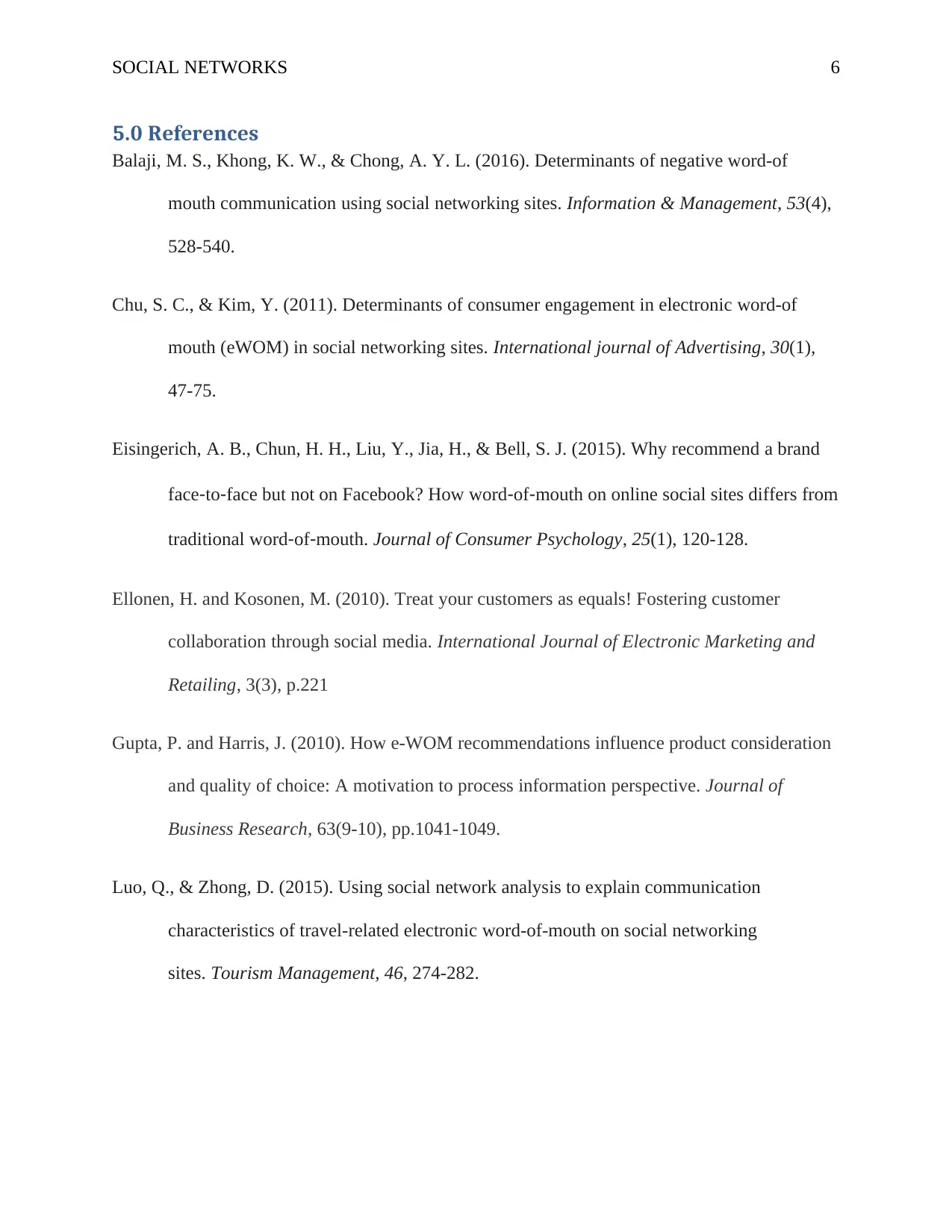
SOCIAL NETWORKS 6
5.0 References
Balaji, M. S., Khong, K. W., & Chong, A. Y. L. (2016). Determinants of negative word-of
mouth communication using social networking sites. Information & Management, 53(4),
528-540.
Chu, S. C., & Kim, Y. (2011). Determinants of consumer engagement in electronic word-of
mouth (eWOM) in social networking sites. International journal of Advertising, 30(1),
47-75.
Eisingerich, A. B., Chun, H. H., Liu, Y., Jia, H., & Bell, S. J. (2015). Why recommend a brand
face‐to‐face but not on Facebook? How word‐of‐mouth on online social sites differs from
traditional word‐of‐mouth. Journal of Consumer Psychology, 25(1), 120-128.
Ellonen, H. and Kosonen, M. (2010). Treat your customers as equals! Fostering customer
collaboration through social media. International Journal of Electronic Marketing and
Retailing, 3(3), p.221
Gupta, P. and Harris, J. (2010). How e-WOM recommendations influence product consideration
and quality of choice: A motivation to process information perspective. Journal of
Business Research, 63(9-10), pp.1041-1049.
Luo, Q., & Zhong, D. (2015). Using social network analysis to explain communication
characteristics of travel-related electronic word-of-mouth on social networking
sites. Tourism Management, 46, 274-282.
5.0 References
Balaji, M. S., Khong, K. W., & Chong, A. Y. L. (2016). Determinants of negative word-of
mouth communication using social networking sites. Information & Management, 53(4),
528-540.
Chu, S. C., & Kim, Y. (2011). Determinants of consumer engagement in electronic word-of
mouth (eWOM) in social networking sites. International journal of Advertising, 30(1),
47-75.
Eisingerich, A. B., Chun, H. H., Liu, Y., Jia, H., & Bell, S. J. (2015). Why recommend a brand
face‐to‐face but not on Facebook? How word‐of‐mouth on online social sites differs from
traditional word‐of‐mouth. Journal of Consumer Psychology, 25(1), 120-128.
Ellonen, H. and Kosonen, M. (2010). Treat your customers as equals! Fostering customer
collaboration through social media. International Journal of Electronic Marketing and
Retailing, 3(3), p.221
Gupta, P. and Harris, J. (2010). How e-WOM recommendations influence product consideration
and quality of choice: A motivation to process information perspective. Journal of
Business Research, 63(9-10), pp.1041-1049.
Luo, Q., & Zhong, D. (2015). Using social network analysis to explain communication
characteristics of travel-related electronic word-of-mouth on social networking
sites. Tourism Management, 46, 274-282.
⊘ This is a preview!⊘
Do you want full access?
Subscribe today to unlock all pages.

Trusted by 1+ million students worldwide
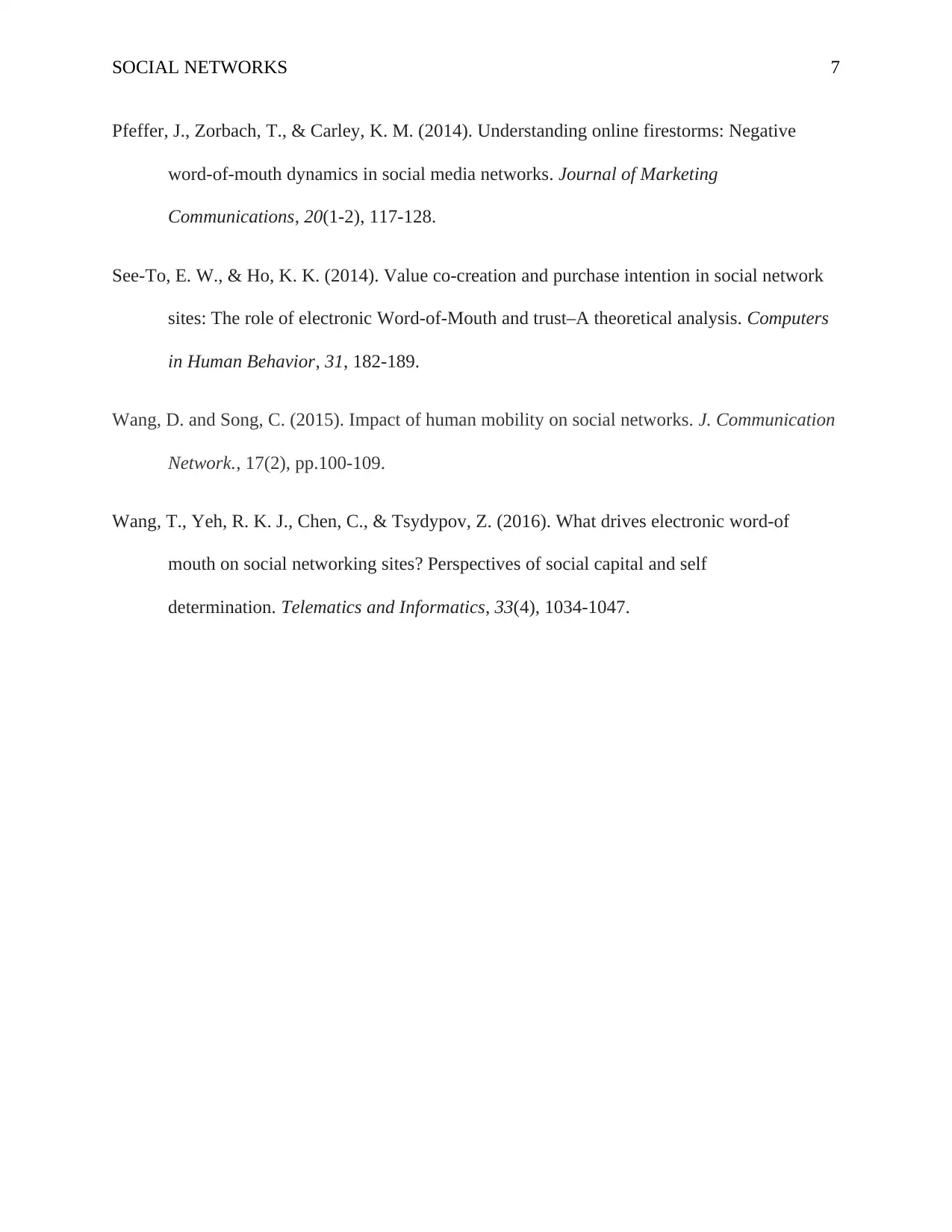
SOCIAL NETWORKS 7
Pfeffer, J., Zorbach, T., & Carley, K. M. (2014). Understanding online firestorms: Negative
word-of-mouth dynamics in social media networks. Journal of Marketing
Communications, 20(1-2), 117-128.
See-To, E. W., & Ho, K. K. (2014). Value co-creation and purchase intention in social network
sites: The role of electronic Word-of-Mouth and trust–A theoretical analysis. Computers
in Human Behavior, 31, 182-189.
Wang, D. and Song, C. (2015). Impact of human mobility on social networks. J. Communication
Network., 17(2), pp.100-109.
Wang, T., Yeh, R. K. J., Chen, C., & Tsydypov, Z. (2016). What drives electronic word-of
mouth on social networking sites? Perspectives of social capital and self
determination. Telematics and Informatics, 33(4), 1034-1047.
Pfeffer, J., Zorbach, T., & Carley, K. M. (2014). Understanding online firestorms: Negative
word-of-mouth dynamics in social media networks. Journal of Marketing
Communications, 20(1-2), 117-128.
See-To, E. W., & Ho, K. K. (2014). Value co-creation and purchase intention in social network
sites: The role of electronic Word-of-Mouth and trust–A theoretical analysis. Computers
in Human Behavior, 31, 182-189.
Wang, D. and Song, C. (2015). Impact of human mobility on social networks. J. Communication
Network., 17(2), pp.100-109.
Wang, T., Yeh, R. K. J., Chen, C., & Tsydypov, Z. (2016). What drives electronic word-of
mouth on social networking sites? Perspectives of social capital and self
determination. Telematics and Informatics, 33(4), 1034-1047.
1 out of 7
Related Documents
Your All-in-One AI-Powered Toolkit for Academic Success.
+13062052269
info@desklib.com
Available 24*7 on WhatsApp / Email
![[object Object]](/_next/static/media/star-bottom.7253800d.svg)
Unlock your academic potential
Copyright © 2020–2025 A2Z Services. All Rights Reserved. Developed and managed by ZUCOL.





